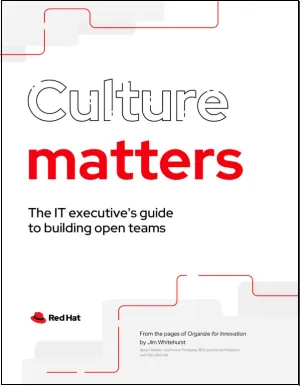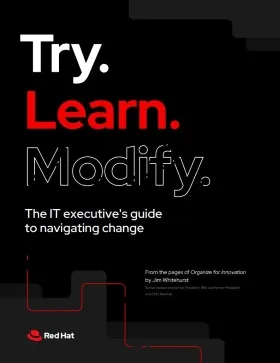The increasing popularity of hybrid work arrangements has many organizations looking for new organizational and cultural strategies.
On top of this, the ability to quickly adapt and innovate is increasingly critical to many organizations’ survival, but innovation is unpredictable and something you can neither plan for nor control.
So what are leaders to do? How can you help new hybrid teams work together productively? How can you retain existing talent and attract new people to your organization? How can you encourage more rapid innovations and harness them more effectively?
By deliberately reshaping your organizational culture to a more open model, you can create the conditions that enable more effective hybrid teams and increase individual engagement while also encouraging innovation, flexibility and growth.
Embracing change
In Organize for Innovation, Jim Whitehurst discusses how a healthy and innovative organizational culture is fundamental to success in our rapidly-changing world—how it’s up to leaders to deliberately create a culture in which innovation is more likely to occur, and more likely to be recognized and harnessed when it does.
Two newly-released executive guides based on Whitehurst’s book address these issues and more.
Building open teams
 Culture Matters: The IT executive’s guide to building open teams gives IT leaders a place to get started, beginning with rethinking their own leadership strategies, developing an open leadership mindset, and leading by example.
Culture Matters: The IT executive’s guide to building open teams gives IT leaders a place to get started, beginning with rethinking their own leadership strategies, developing an open leadership mindset, and leading by example.
Be a catalyst, not a commander
An open organization requires leaders who are agents of change rather than commanders who dictate every move and every decision. Open leaders create the conditions for success, connecting the right people to the right problems at the right time. More importantly, they then step aside, empowering their teams to take control of the process.
Create culture with clarity
Vital to the success of an open organization is having specific, concrete and clearly communicated goals that are tracked openly and revisited regularly. When goals are clear and well-understood, it’s easier for everyone to work together with the same intentions and a shared purpose.
Break old habits
Implementing and sustaining cultural change necessarily involves breaking some deeply ingrained habits. Instead of holding fast to control, open leaders push decision-making power out to the edge -- to the people and teams working more closely with the problems at hand.
Leading in a time of disruption
 Try. Learn. Modify: The IT executive’s guide to navigating change outlines how organizations can evolve in the wake of COVID-19. It’s increasingly clear that traditional planning techniques, top-down hierarchical structures, and rigid processes are no longer helpful, so what are organizations to do?
Try. Learn. Modify: The IT executive’s guide to navigating change outlines how organizations can evolve in the wake of COVID-19. It’s increasingly clear that traditional planning techniques, top-down hierarchical structures, and rigid processes are no longer helpful, so what are organizations to do?
Try. Learn. Modify.
As cycles of innovation and disruption are accelerating, conventional formulas are no longer relevant. Long-term planning is all but futile, with shorter-term experimentation and iteration providing greater value and more flexibility in less time.
Open organizations are most able to embrace this strategy, with dynamic, networked teams collaborating and innovating together based on a shared set of goals and values, without the centralized control of more hierarchical structures.
Focus on culture
Culture starts at the top, and in an open organization, leaders must embody cultural values in their actions as well as their words. And developing an open culture isn’t just a checkbox on a to-do list -- it’s an ongoing process of evolution that allows an organization to become stronger, more resilient, and more agile every day.
So long as values and action are aligned, organizational culture can drive greater innovations more quickly, but if those are misaligned, organizations will flounder. A successful organizational culture depends on clarity in mission, purpose and values.
Let the best ideas win
Encouraging and empowering everyone, regardless of their position, to share and discuss ideas is a key aspect of an open organization. It’s only through contributions from a wide array of people with different backgrounds, perspectives and experiences that the best ideas will emerge.
(Re)think the future
Planning for the future is tougher than ever, but even small, incremental advancements towards openness can go a long way towards fostering a culture of innovation and individual empowerment.
Every step taken towards establishing an open and transparent culture will increase engagement, encourage novel thinking and experimentation, and encourage people’s intrinsic motivations, all of which are key sources of innovation.
Embracing open
It’s clear that old organizational models are no longer effective. New innovations, disruptions and transformations are happening every day, produced by organizations that are faster and more agile. And the people at the heart of these are demanding more flexible, fulfilling and human working conditions.
In the face of so much change, organizations that want to thrive need to adapt. By embracing openness and moving toward a more open organizational culture, organizations can become more creative, responsive, attractive and resilient.
Learn more
If you’re interested in learning more about the power of open culture and how it can transform your organization, these executive guides and Whitehurst’s e-book are a good place to start.
Download your copies today.
À propos de l'auteur
Deb Richardson joined Red Hat in 2021 and is a Senior Content Strategist, primarily working on the Red Hat Blog.
Plus de résultats similaires
Red Hat's commitment to the EU Cyber Resilience Act: Shaping the future of cybersecurity standards
Data-driven automation with Red Hat Ansible Automation Platform
Technically Speaking | Platform engineering for AI agents
Technically Speaking | Driving healthcare discoveries with AI
Parcourir par canal
Automatisation
Les dernières nouveautés en matière d'automatisation informatique pour les technologies, les équipes et les environnements
Intelligence artificielle
Actualité sur les plateformes qui permettent aux clients d'exécuter des charges de travail d'IA sur tout type d'environnement
Cloud hybride ouvert
Découvrez comment créer un avenir flexible grâce au cloud hybride
Sécurité
Les dernières actualités sur la façon dont nous réduisons les risques dans tous les environnements et technologies
Edge computing
Actualité sur les plateformes qui simplifient les opérations en périphérie
Infrastructure
Les dernières nouveautés sur la plateforme Linux d'entreprise leader au monde
Applications
À l’intérieur de nos solutions aux défis d’application les plus difficiles
Virtualisation
L'avenir de la virtualisation d'entreprise pour vos charges de travail sur site ou sur le cloud
